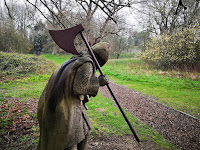 |
| Coat of Arms, Battle Abbey & School in distance |
We returned to Battle the next morning, misty and moisty, for the 10am opening after stopping by Mrs Burtons Tea House opposite the Abbey for breakfast. As members of English Heritage we got in free (plus free parking) and spent two hours wandering about the quiet battlefield site, accompanied by the songbirds and burrowing rabbits. The Battle of Hastings, the most important in English history, took place on the grounds where we walked and I tried to imagine the ferocity of those two battling armies that chilly October day over 1000 years ago. It was the last successful military invasion of England and transformed the country forever.
 |
| Undercrofts and tower, Battle Abbey |
William the Conqueror founded Battle Abbey a few years later out of gratitude for his victory and as a monument to the thousands who died here. It is a partially ruined Benedictine abbey built by Bill after the order of the Pope in 1070 for the Normans to do penance for killing so many people. The high altar was supposed to be placed on the spot where King Harold fell in that battle. I remember seeing this accurately portrayed on the beautiful Bayeux Tapestry when we visited Bayeux in France a few years ago. Most of the church was destroyed in 1538 under Henry VIII, the monks pensioned off and eventually the abbey and its land were sold to various barons until purchased by the British Government in 1976. There you have it - a 1000 years of history in 100 words.
 |
| Archer, carved in wood |
 |
| the Dorter and remains of the cloisters |
 |
| inside the Cloisters |
 |
| the Battle field, overgrown now with daffodils |
 |
| Mrs Burtons Tea House, Battle (thank you for the scones and jam to go) |
It was time to get in the car and head towards Gosport, (God's Port in the very old days) our stop for the next two days, a 2 hour and thirty minute drive on the crowded M25 towards Heathrow and A3 to Portsmouth. We gassed up for the first time on route, planning to keep the tank topped off to avoid any unnecessary surprises the further north we got. The Hampshire sun was trying to come out when we arrived at the Bridgemary Manor Pub and Hotel around 3 PM and, after going for a walk to stretch our legs, spent the evening there bending the elbow and enjoying some typical pub fare.
 |
| Bridgemary Manor Pub and Hotel |
Next day was considerably cooler with the occasional burst of hail and a cold wind coming down from the north. Marie is the family historian and we had planned while in this area to visit the Hampshire Genealogical Society located at the Archive building in beautiful Winchester, 40 minutes on the motorway northwest of here. The purpose of the visit was to extend our knowledge of my great-great-grandfather William Steward, a carpenter by trade, whose name we have continued to this day. Looking through microfiche records and talking to some friendly ladies from HGS we corrected some dates of christenings and burials for his family but came up blank when it came to his death. We thought it might be in the old Rowner church not far from our hotel, Saint Mary the Virgin. But before leaving affluent Winchester we walked through the High St to gaze in wonder at the magnificent Winchester Cathedral ( irreverently immortalized in history by the song of the same name by the one-hit-wonder the New Vaudeville Band in 1966). It is over 1000 years old and one of the best preserved medieval cathedrals in Europe, with a long and wide nave in the Perpendicular Gothic style, an Early English retrochoir and Norman transepts and tower, a jewel we had not originally planned to visit. Returning to Gosport we drove over to Saint Mary and wandered among the ancient grave stones, some dating back to the 14th century! It was a typical English cemetery, dark and forlorn for enduring yet another uncountable winter, tree branches reaching down to rest against the old lichen covered stone, the occasional spray of yellow primrose poking through the tangled grass. Many of the stones were ineligible from the mid 1800s, the time we thought would be the most rewarding and we may have missed an important clue in our search and not seen it. We had left our contact email with the Society thinking perhaps they can solve this 150 year old family mystery. Nonetheless, this is the Church where great grampa Isaac Steward was Christened; he is noted in the 1851 Census that he lived at Bridgemary Farm Cottage on Fareham Road. Then it was back to the hotel and dinner in the pub and plans for our drive to Crockernwell, West Devon on the morrow. GWS

 |
| the Buttercross, Winchester, 15th century |
 |
| Winchester Cathedral |
 |
| Saint Mary the Virgin, Church of England, Rowner, Hampshire |
 |
| a new grave among the old, a young hero from WW2 |





















